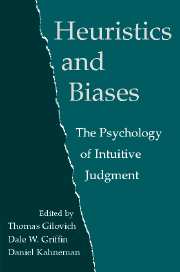Introduction – Heuristics and Biases: Then and Now
Published online by Cambridge University Press: 05 June 2012
Summary
In the late 1960s and early 1970s, a series of papers by Amos Tversky and Daniel Kahneman revolutionized academic research on human judgment. The central idea of the “heuristics and biases” program – that judgment under uncertainty often rests on a limited number of simplifying heuristics rather than extensive algorithmic processing – soon spread beyond academic psychology, affecting theory and research across a range of disciplines including economics, law, medicine, and political science. The message was revolutionary in that it simultaneously questioned the descriptive adequacy of ideal models of judgment and offered a cognitive alternative that explained human error without invoking motivated irrationality. The initial papers and a variety of related work were collected in a 1982 volume, Judgment under Uncertainty: Heuristics and Biases (Kahneman, Slovic, & Tversky, 1982). In the time since, research in the heuristics and biases tradition has prospered on a number of fronts, each represented by a section of the current volume. In this opening chapter, we wish to put the heuristics and biases approach in historical context and discuss some key issues that have been raised since the 1982 book appeared.
HISTORICAL OVERVIEW
Any discussion of the modern history of research on everyday judgment must take note of the large shadow cast by the classical model of rational choice. The model has been applied most vigorously in the discipline of economics, but its considerable influence can be felt in all the behavioral and social sciences and in related policy fields such as law and medicine.
- Type
- Chapter
- Information
- Heuristics and BiasesThe Psychology of Intuitive Judgment, pp. 1 - 18Publisher: Cambridge University PressPrint publication year: 2002
- 88
- Cited by



